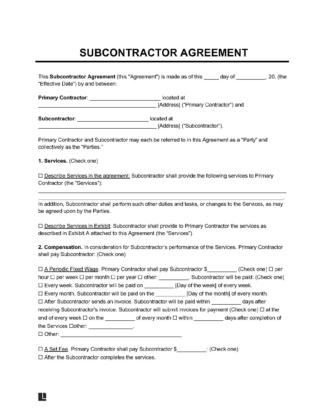
Use a subcontractor agreement to lay out the terms and conditions between a contractor and a subcontractor.

Updated February 29, 2024
Written by Sara Hostelley | Reviewed by Brooke Davis
A subcontractor agreement is a legal document a hiring contractor uses to bring another worker or company, known as the subcontractor, to assist with a project or deliver a particular service. This practice is common in industries like construction and manufacturing, where the projects require specialized skills or are complex or time-sensitive.
Typically, the independent contractor already holds a service contract with a client and may bring in a subcontractor to handle specific aspects of the project. The contractor should attach the subcontractor agreement to the contractor’s agreement, specifying the original client and detailing the terms that govern the subcontractor’s involvement in the project.
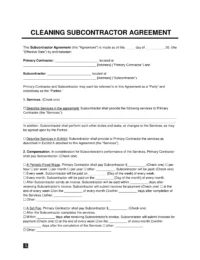 Cleaning Subcontractor Agreement Template" width="200" height="260" />
Cleaning Subcontractor Agreement Template" width="200" height="260" />
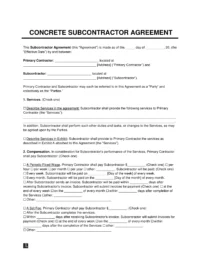
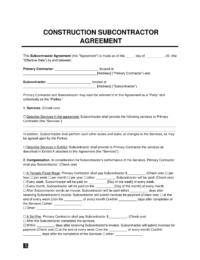
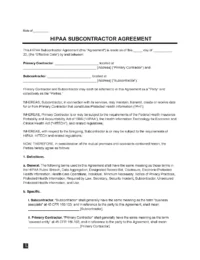
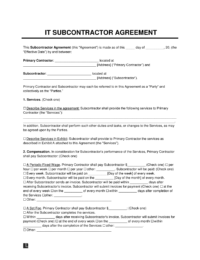
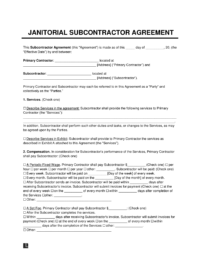
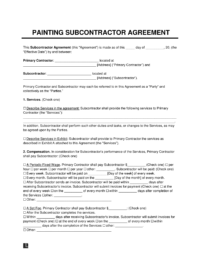
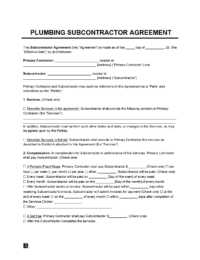
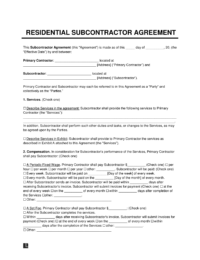
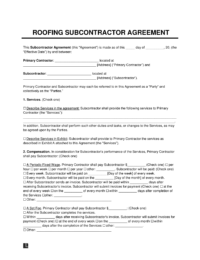
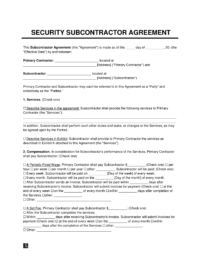
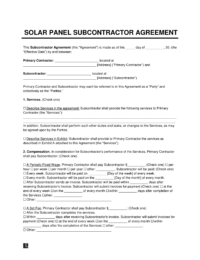
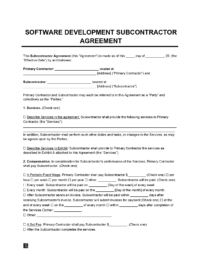
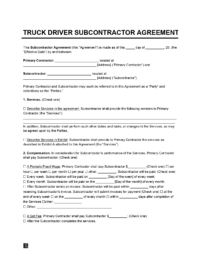
A subcontractor is an individual or company that works in a specialized industry and provides services to a contractor for a fixed fee.
Subcontractors are prevalent in the construction industry, where the general contractor schedules and budgets the entire project and then subcontracts with carpenters, electricians, plumbers, and others to complete the project.
Subcontractors may be freelancers, contractors within their area, or product vendors. They are independent entities working for themselves, not the general contractor. They only enter contractual relationships with general contractors to complete specific projects.
The primary difference between an employee and a subcontractor is that the employee works for the company. The subcontractor is an independent contractor carrying out services for the primary contractor.
Employees and subcontractors differ in terms of the following factors:
Employers provide company equipment and tools for employees to use while they work. On the other hand, subcontractors typically have to provide their own materials and bring them to each job site.
Employees receive hourly pay or salaries from their employers, and the employers withhold payroll taxes from their pay. An employee may receive benefits from their employers as part of their employment contract, such as vacation time, sick days, holiday pay, and pension plans.
Subcontractors receive payments based on the work they deliver. They’re responsible for paying their taxes and acquiring their own insurance.
Employers hire employees to complete various job duties and tasks during the workday. An employee’s daily schedule may differ depending on the company’s needs.
Alternatively, a subcontractor carries out a specific job within their specialty according to the terms of their subcontractor agreement.
An employer may discipline an employee with a warning notice or other disciplinary actions. If the employee’s employment is at will, the employer can terminate the relationship at any time without notice as long as the reason isn’t discriminatory or illegal.
Contractors can terminate the subcontractor agreement if the contractor is willing to pay the costs of a breach. They must give the proper notice if the contract dictates a notice period. They must also issue payment upon termination according to the contract’s terms. For example, they may have the obligation to pay for work the subcontractor completed up to the termination date.
Explore the processes for taxing subcontractors below:
Subcontractors pay income tax like traditional employees, but they’re also responsible for self-employment tax. Self-employment tax encompasses Medicare and Social Security taxes.
Employers usually withhold 6.2% of an employee’s paycheck to pay for Social Security and 1.45% of an employee’s paycheck to pay for Medicare. The employer will then match the contributions, creating a total contribution of 12.4% for Social Security and 2.9% for Medicare.
Alternatively, contractors don’t withhold any amount from subcontractors’ paychecks. Instead, subcontractors are solely responsible for paying the self-employment tax themselves. This percentage adds up to 15.3%, which is divided into 12.4% for Social Security and 2.9% for Medicare [1] .
Because there’s no employer to withhold taxes from a subcontractor’s paycheck, the subcontractor must make estimated tax payments to the Internal Revenue Service (IRS) each quarter. These payments cover their income tax and self-employment tax obligations.
Subcontractors can deduct necessary and ordinary business expenses to reduce their taxable income. For example, they can report expenses like home office costs, office expenses, equipment, tools, materials, and travel costs relating to their work.
They can also contribute to retirement savings accounts like solo 401(k)s and Simplified Employee Pension Plan (SEP) IRAs to lower their tax obligations.
Before they start working for a contractor, a subcontractor fills out Form W-9 to inform the contractor of their taxpayer identification number and other personal information.
Then, the contractor (whether a business or person) reports the total amount they paid to the subcontractor using Form 1099-NEC. The contractor submits the original form to the IRS and provides a copy to the subcontractor.
The subcontractor references this form to report their expenses and income on Schedule C (Profit or Loss from Business) when filing their personal income tax return on Form 1040. Then, they use the net result (loss or profit) from Schedule C to calculate the amount of self-employment and income tax they owe.
Before you look for a subcontractor, you must determine what they will do. A subcontractor needs to know what you want them to do so they can give you an accurate bid.
For instance, if you are remodeling a house, your subcontract for the roof should include the square footage, the materials you want to use, and the start and end dates.
In any industry, from construction to web design, the best way to find reliable specialists is to ask others in your field.
You should also look on review sites like Yelp and Google and see what their clients and customers say. Gather a list of potential bidders for your project based on their experience and qualifications.
Contact your proposed subcontractors with your project outline and ask if they want to bid. It would be best if you gave them a deadline for their bid (days or weeks, depending on the project size).
Their bid should include how they plan to meet your project’s requirements, a proposed timeline, a cost estimate, payment terms, unique selling points (USPs), and other essential details.
Interview the subcontractors who seem like they have high potential. Learn their workflow and assess their problem-solving and communication skills. Negotiate the project’s terms if necessary. Use your interviews to settle on the right subcontractor for your project.
Prepare a detailed subcontractor contract that includes the scope of work, project timeline, payment terms, quality standards, termination conditions, and confidentiality clauses.
Both parties should review and sign the contract once they agree to all terms.
A subcontractor agreement should include the following:
Fill in the date of the contract’s creation and the name and address of the general or primary contractor and subcontractor.
You should also include details of the services the subcontractor will provide. If you can describe the services in a line or two, complete the section on the page. If you need more space to complete your description, attach a second page with a longer description of the subcontractor’s duties.
For example, if you’re writing a construction contract, you may have to detail a subcontractor’s duties for electrical installation. You should detail how many homes they have to provide the installation for and describe specific tasks, such as installing the main service panel, circuit breakers, and all necessary conduits for each home.
The contractor might pay the subcontractor for their services according to the primary contract. Review each option and select the one that best fits your situation:
The subcontractor will receive a set amount on a weekly/monthly basis or upon submission of an invoice.
The subcontractor will receive a set fee upon completion of the project or submission of an invoice.
Some contractors pay their subcontractors when the subcontractor reaches specific points in the project. The contractor will pay the subcontractor a certain amount upon completion of each milestone or receipt of an invoice following the milestone.
Include the date the services will start and when the contract will terminate:
Specific types of dispute resolution may be mandated in your state. Choose the relevant dispute resolution:
If you need to include any non-compete/non-disclosure clauses, expense details, or further information, then do so here. Finalize the agreement with the names and signatures of both the contractor and subcontractor.
Download a subcontractor agreement template in PDF or Word format below: